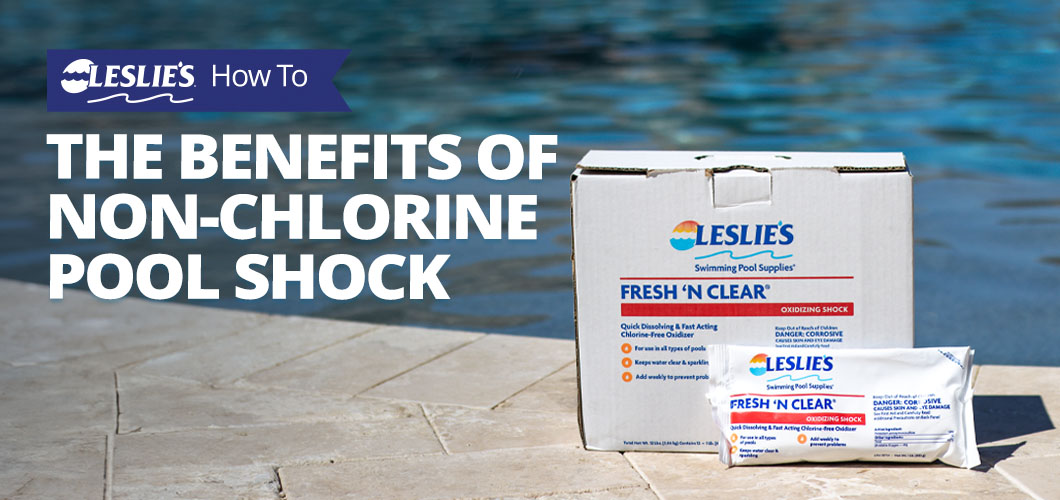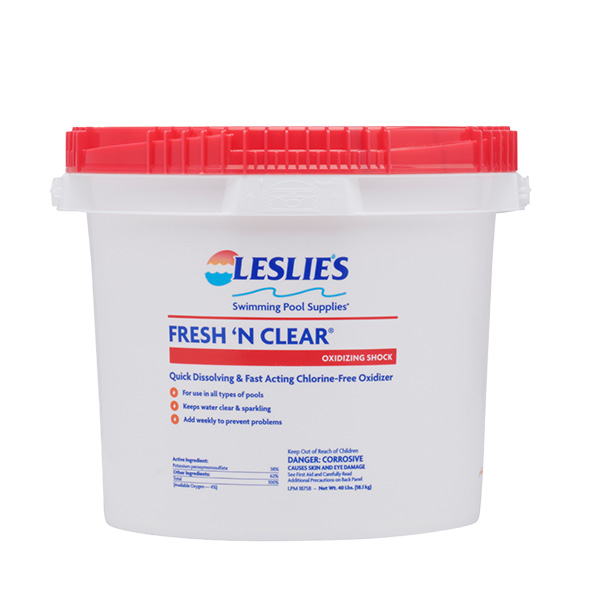
The Benefits of Non-Chlorine Pool Shock
There are all kinds of different pool chemicals available, and it can be hard to sort out which ones you actually need. If you’re looking to improve chlorine performance and make your pool water sparkle, non-chlorine shock (also known as chlorine-free shock) might be the answer. Below, you'll find everything you need to know about non-chlorine shock and when to use it in place of traditional chlorine-based shock.
Shocking the Pool

As your chlorine works to keep your pool clean, it attaches to the ammonia present in your water. The resulting reaction converts your Free Available Chlorine (FAC) into inactive Combined Chlorine, otherwise known as chloramines. Chloramines produce a strong, unpleasant smell, which is often mistaken for a pungent chlorine odor. When chloramines are present in the water, it can seriously irritate your skin, eyes, nose, and throat. That’s where pool shock comes in — to break down those chloramines.
Most people superchlorinate their pool water with a chlorine-based granular pool shock, such as stabilized dichlor or unstabilized cal-hypo. Adding the proper amount of chlorine pool shock will destroy inorganic chloramines and oxidize organic contaminants in the water. Other reasons for superchlorination include if the pool has algae, if there's either low or no Free Available Chlorine in the pool (below 1.0 ppm), or if there has been a fecal accident or other major source of contamination.
Chlorine-free shock, such as Leslie’s Fresh ‘N Clear, cannot raise chlorine levels, nor can it kill algae and bacteria in the pool. So what can it do? This, my friends, is where unchlorinated pool shock truly shines.
PRO TIP: If you close your pool for winter, chlorine-free shock is the perfect way to ensure your pool remains healthy until you reopen it again in the spring. It will oxidize contaminants to keep your existing chlorine residual working effectively, and you won't have to worry about it bleaching pool surfaces.
Benefits of Non-Chlorine Pool Shock
Although, as the name implies, non-chlorine shock doesn't contain chlorine, it's still a powerful type of oxidizer. Once added to the pool, it quickly works to break down the non-living organic contaminants in your water, which would normally be targeted by your active Free Available Chlorine (FAC). This in itself serves a couple of different purposes. For starters, it frees up your existing FAC residual to continue fighting off the living organic contaminants in your water, such as disease-causing microorganisms and algae. Second, by breaking down the non-living organics in the water, this helps curb chloramine production in your pool. It's a win-win for pool owners! These are some of the reasons why non-chlorine pool shock is a must-have chemical for any swimming pool:

- Leslie's Fresh 'N Clear contains a clarifier to enhance the clarity of your pool water
- Destroys non-living organic contaminants to enhance chlorine performance
- You can swim as soon as 15 minutes after application — no need to wait for hours after shocking the pool!
- Has a near-neutral pH of approximately 7.4, leaving a minimal impact on pH and Total Alkalinity
- Does not add Cyanuric Acid to the water
- Will not increase Calcium Hardness levels
- Prevents and reduces inorganic chloramines
- Removes strong ammonia and chloramine smells from the pool
- Ideal for weekly shocking if the FAC level is 2.0 ppm or higher
- Regular usage may reduce chlorine consumption
- Safe for all pool surfaces
- Compatible with any pool or spa using chlorine tablets, bromine, salt systems, ozonators, or mineral systems
- Reactivates bromine
- Gentle on swimmers (reduces itchy skin and irritated eyes)
- Will not bleach swimsuits or pool liners
When is it Best to Use Non-Chlorine Shock?
The benefits of chlorine-free shock may sound enticing enough to make you want to use it all the time. However, there's a time and place for it. When should you use non-chlorine shock? That's easy — just test your water to check the chlorine levels. In general, you should aim to add shock to the pool at least once a week. The type you use depends on the results of your water test.
If your Free Available Chlorine is below 2.0 ppm, use chlorinated pool shock. If the FAC level is above 2.0 ppm, using non-chlorine shock will help keep your existing chlorine working efficiently and prevent chloramines from forming. When the Total Available Chlorine number is more than 0.3 ppm above your FAC level, you have a chloramine problem that needs to be addressed — add shock to break them down.
If you’re still not sure what kind of shock is best for your pool, stop by your local Leslie’s and talk to the experts, or bring in a water sample for a FREE AccuBlue® water test. By looking at your pool's chlorine levels and other aspects of water chemistry, we'll be able to help determine exactly what your pool needs. Be sure to check out our helpful resource center article that goes over the three types of granular pool shock, the differences between them, and when you should use each one.